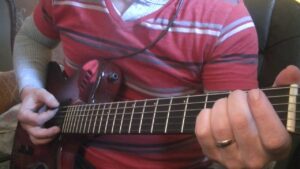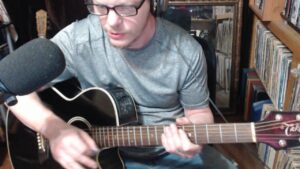Home | Just Acoustic Song Archive | Video Lesson Spotlight | Front Porch Strumming | Just Acoustic Lessons
Latest Acoustic Lessons
September 4, 2022Just Acoustic LessonsChords have a mind of their own in the context of a song. In any given key, certain chords are much better at following the previous chord than others. The harmonic properties of chord progressions lead our ears by a leash. For example a song WANTS to end on the I chord. The song will feel incomplete or have a sense of ‘hanging’ if a song ends on any other chord.
That’s our ears telling us we want resolution. See, while your mind not understand all the theory behind it, your ears certainly do.
Here are some ground rules of what chords want to do:The I chord can lead to any chord. That’s the privilege of being the I chord, because it’s the same as the key (song in C = I is C).
The ii chord leads to to IV,V,vi.
The iii chord leads to the ii,IV,vi
The IV chord leads to the I,iii,V,vii
The V chord leads to the I
The vi chord leads to the ii,IV,V,I
The vii chord leads to the I,iiiIn Summary
A chord may be built upon any note of a musical scale, therefore a seven-note scale allows seven basic chords, each degree of the scale becoming the “root” or “tonic” of its own chord. A chord built upon the note A is an A chord: however, since any progression may be played in any key, the fundamentals of harmony are best grasped by numbering the chords according to the step of the scale they are built upon, upwards from the key-note. The structural meaning of a harmony depends exclusively upon the degree of the scale.
Any major scale gives three major triads that together include, and so can harmonize, every note of that scale. They are based on the first, fourth, and fifth scale degrees (the tonic, subdominant and dominant).
The same scale also provides three relative minor chords, one related to each of the three major chords. These are based upon the sixth, second and third degrees and stand in the same relationship to one another as do the three majors.
Apart from these six common chords there will be one step of the scale that gives a diminished chord.
This lesson is from the Guitar Alliance members-only course called “Killer Chords”Related posts:
Guitar Rhythm Primer [...]
September 5, 2022Just Acoustic LessonsThis lesson will serve as a good starting point for playing rhythm guitar.
Following The Beat
When listening to music, you might find yourself tapping your foot along with the beat. The beat keeps track of the songs time, by creating a regular pulsation against which the length can be measured.
The beat may be fast or slow, but it must be regular. Each beat has to have the same duration.
You’ve all heard the lead into a song when the lead singer counts to four and then the music begins. Or perhaps you’ve heard a drummer click the drumsticks together to begin a song. In both cases, they are setting the tempo of the song. The tempo is simply the speed at which the song is played.
Standard Time
Standard time, the most common time, means the music gets 4 beats per measure. A measure is a way to break the song down into small groups that are separated by bars.
Eighth Note StrummingRelated posts:
Chord Leading [...]
Do you have other memberships besides “Just Acoustic”? Visit Your Account to access them.

